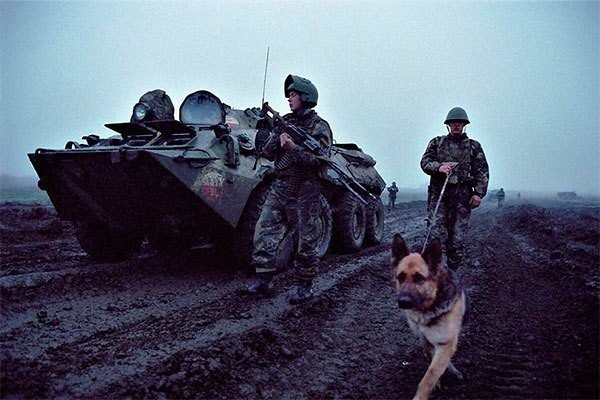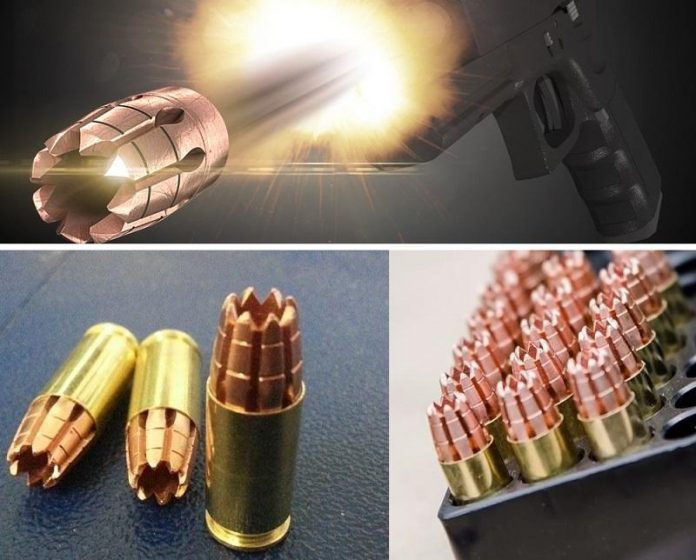
The first theory, why the bullet wound was so severe consequences (even if not killed immediately), It was the idea of poisoning of tissues and lead powder. That explains a severe bacterial infection of the wound channel, which is usually treated with a hot iron and boiling oil. The suffering of the wounded from this "therapy" is magnified up to a lethal pain shock. Nevertheless, scientists have to 1514 We were able to identify five characteristics of gunshot wounds: burn (adustio), injury (contusion), osadnenie (attrition), fracture (fracture) and poisoning (poison). Barbarous method of pulling the bullet and pouring boiling oil managed to break only to the middle of the XVI century in France.
Surgeon Ambroise Pare at 1545 year during the next battle facing an acute shortage of boiling oil for the wounded - some of the soldiers had a bandage. Not relying on their recovery accidents, Pare some time checked the bandage and was amazed. The wounds were in a much better condition with respect to those, who had the "saving" of oil. The Frenchman also refuted the idea, the bullet in flight is heated and additionally burn human tissue. Ambroise spent, probably, the first ever experiment in wound ballistics, firing bags of wool, tow and even gunpowder. Nothing broke and did not explode, therefore rejected the theory of the impact of the burn.
 The surgeon Pare Amboise
The surgeon Pare Amboise
The history of mankind gives a very extensive material to physicians and scientists to study the impact of a bullet in the flesh - for three centuries the largest steel Thirty Years' War 1618-1648 gg., Seven Years' war 1756-1763 gg., military campaigns of Napoleon 1796-1814 gg. and other small slaughter.
One of the first full-scale testing activities bullet object, similar to human flesh, Frenchman spent Guillaume Dyupyuitren at 1836 year. Military surgeon fired corpses, boards, lead plates, felt and learned, that the firearm has a funnel-shaped channel, wide base facing towards the outlet. Conclusion of his work was the idea, that the size of the outlets will always be more input. Later (at 1848 year) this idea has challenged Russian surgeon Nikolai Pirogov, which is based on its extensive experience and observations of the wounded soldiers during the siege of the village of Salt have, that "the effect of Dupuytren" is only possible when the bullet hit the bone.
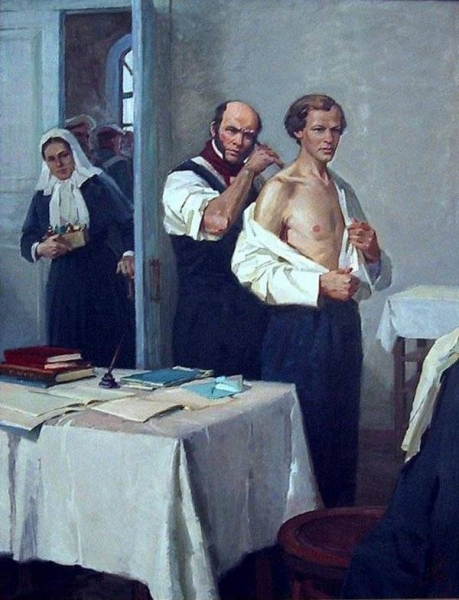 «n-l. Pies examines the patient DI. Mendeleev», AND. Quiet
«n-l. Pies examines the patient DI. Mendeleev», AND. Quiet
A piece of lead in the process, deforms and breaks the surrounding tissue. pies proved, that when the bullet passes through soft tissue only, outlet is always less and have included. All of these observations and experiments have been valid for the middle of the XIX century - the battlefields ruled dulnozaryadnye smoothbore gun with a circular low-velocity bullet (200-300 m / s).
We made a small revolution in 1849 year bullet Minya conical shape and much larger flight speed. Getting a bullet in a man cause very serious damage, very reminiscent of the explosion effect. here, he wrote the famous Pirogov 1854 year: "I saw the Caucasus breaking bones shattered by bullets cheresskimi, but before the siege of Sevastopol I never saw fragmentation bullets of tissue at such long distances ".
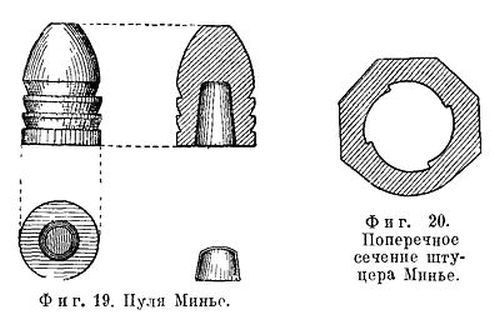 Minié ball and a cross section fitting Minié
Minié ball and a cross section fitting Minié
Minié ball played a sad role for Russia in the Crimean War. But the evolution and there has not stood still — Needle Rifle Dreise and Shasspo had already unitary cartridge with cylindrical-conical bullet of small caliber with a very high speed at that time - 430 m / s. It is with these bullets began bringing additional suffering bullet deformation in tissues.
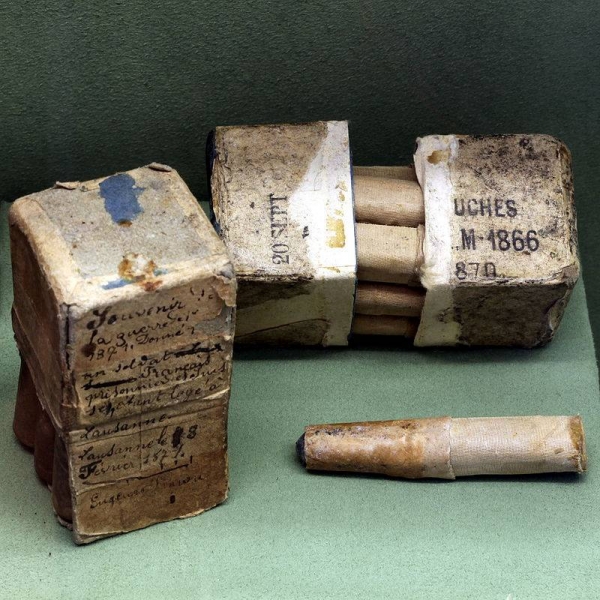
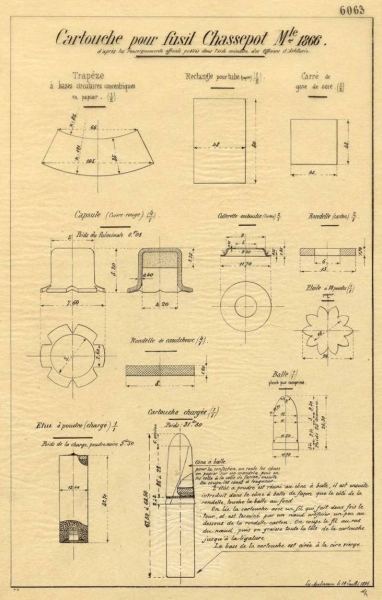 Paper cartridges Shasspo
Paper cartridges Shasspo
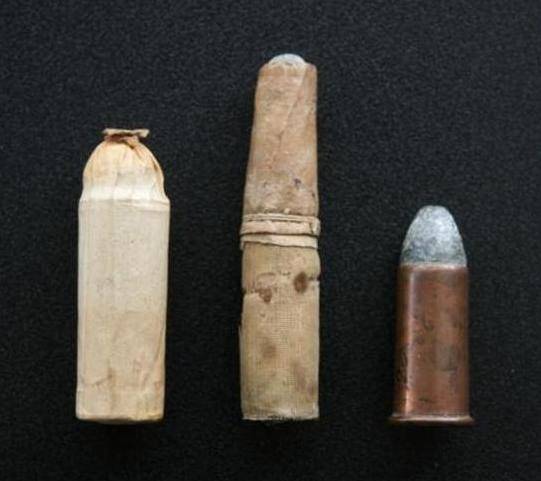 Ammunition for rifles needle. Left Dreise, in the center of Shasspo
Ammunition for rifles needle. Left Dreise, in the center of Shasspo
Pirogov 1871 , he wrote: "Bullets Shasspo much more likely to be a change in form, disintegration and detachment of particles, and wounds, applied these bullets from close range in the 50-100 steps, connected with an incredible destruction of soft and hard body parts ".
Explanation barbarian burst effect of new bullets, scientists have advanced a lot of hypotheses:
— mushroom deformation and melting bullet;
— the idea of rotating the slug and the formation of the boundary layer;
— hydraulic theory;
— shock and hydrodynamic theory;
— hypothesis air concussions and head ballistic wave.
The first hypothesis, scientists have tried to prove the following provisions. Bullet, if it enters the body, deforms and expands in the head, pushing the boundaries of the wound channel. Besides, researchers have proposed an interesting idea, whereby a lead bullet when fired from close range melted particles and liquid lead, due to the rotation of the bullet, sprayed sideways. It appears so terrible funnel channel in the human body, expanding to the outlet.
The next thought was the approval of the hydraulic pressure, resulting when a bullet in the head, chest or abdominal cavity. Explorers brought upon the idea of shooting the empty and filled with water banks. effects, as is known, completely different - a bullet through an empty tin can pass, leaving only a neat hole, while, as a water-filled container bullet just breaks. These profound misconceptions dispelled Nobel Prize Swiss surgeon Theodor Kocher, has become, properly, one of the founders of medical wound ballistics.
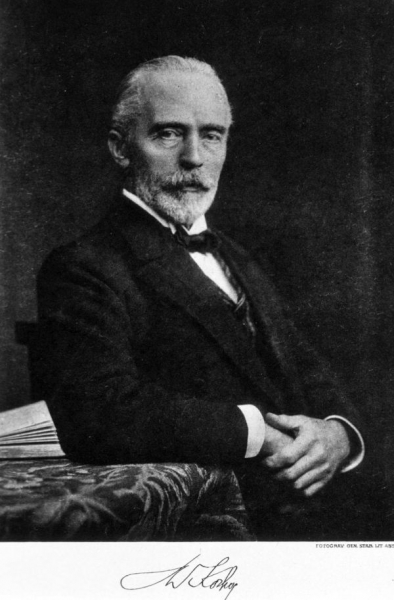 Emil Theodor Kocher
Emil Theodor Kocher
Kocher after many experiments and calculations in the 80-ies of the XIX century proved, that the melting of the bullets on 95% It has no meaning for striking the fabric, since it is negligible. In the same time, surgeon after bombardment gelatin and soap confirmed mushroom bullet deformation in tissues, but it also was not so much and did not explain the "explosive effect" injured. Kocher simple scientific experiment showed a slight rotation of the bullet impact on the nature of injuries. Rifle bullet rotates slowly - only 4 turnover 1 meter path. That is no big difference from what weapon a bullet - a rifled or smoothbore. The mystery of the interaction of the bullets and human flesh and remained murky.
Until now, there is an opinion (formulated at the end of the XIX century) the impact on boundary layer wound, located behind the flying bullets and forming a turbulent flow. With the penetration of the bullet in the flesh is its "tail" part drags the fabric, seriously injuring organs. But this theory does not explain the destruction of organs and tissues, located at some distance from the head of bullets. Next was the theory of hydrostatic pressure, very easy to explain the behavior of bullets in the tissue - is a small hydraulic press, creating an explosive shock pressure, extending in all directions with equal force. Just then we can recall school thesis, that man 70% water. It would seem, bullet impact on the flesh is explained simply and clearly. but, all medical records European scientists have confused Russian surgeons headed by Nikolay Pirogov.
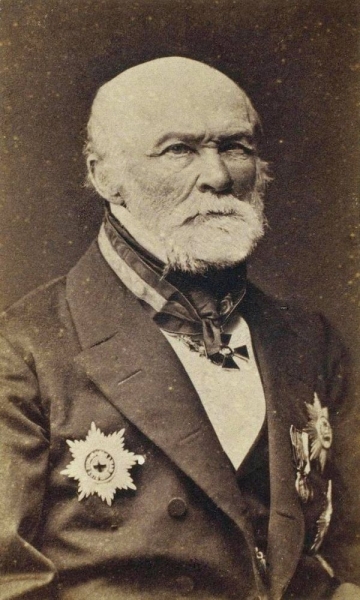 Nikolay Pirogov
Nikolay Pirogov
Here is what the domestic military doctor had said at the time: "We will make the most obvious way, it (the impact of the bullets on the body) It is always equal to the product of mass and speed ... Weight, speed and accuracy - these are the three conditions, which is generally determined by the destructive action of throwing bodies ". Thus was born the theory of shock action gunshot shells, established in Russia. The highest value was paid to the speed of a bullet, of which were in direct dependence and impact force, and penetrated by.
The most heavily involved in the topic Surgeon Tile Vladimir Avgustovich, who carried out a very "visual" experiences with unfixed corpses. The skulls were pre trepan, that is, they "cut out" holes, and then is fired in the area, located close to the hole. If you follow the water hammer theory, the result medulla partially just flew through a prepared hole, but this was not observed. In the end, we came to the conclusion, that the kinetic energy of a bullet - this is the main impact factor of influence on the living flesh. Thiele in connection with the written: "The more energetically striking force of the bullet, the greater amount of kinetic energy supplied particles tissues ".
Just at this time, in the early XX century, were comparative studies of the harmful effect of 10.67 mm of lead bullets for his rifle Berdan an initial rate 431 m / s and 7.62 mm bullet shell arr. 1908 Year rifle Mosin (munition speed 640 m / s).
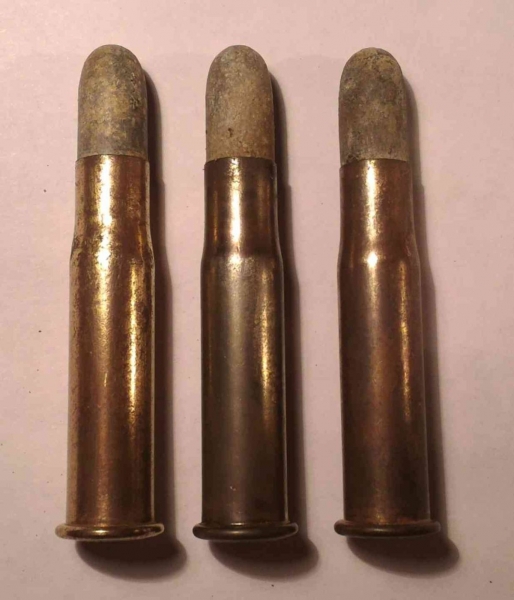
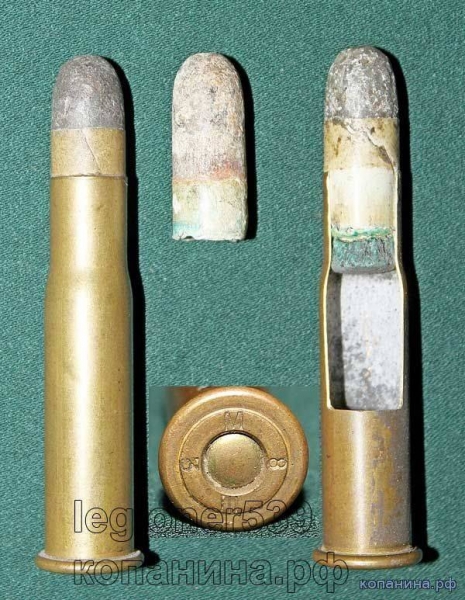 Cartridges and bullets for his rifle Berdan
Cartridges and bullets for his rifle Berdan
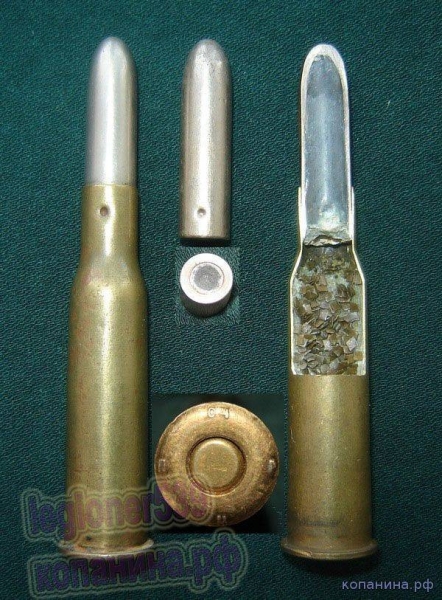 Cartridges and bullets rifle Mosin
Cartridges and bullets rifle Mosin
And in Russia, and in Europe with the aim of the work was to predict the nature of the gunshot wounds of the bullet shell in future wars, and develop treatment methods. A lead bullet in the dura seemed much more "humane", than classic non-enveloped, since rarely it deformed in the tissue and does not cause a pronounced "explosive effect". But there have been skeptics of Surgeons, fair to say, that "humanity is not bullet, and the hand of military surgery " (Not the bullets are human; is the human Bechandlung of the field doctor).
Similar comparative studies have forced the British to think about the effectiveness of its 7.7-mm shell bullets to the Lee-Enfield against rock fanatics in the north-western India on the border with Afghanistan. In the end, we came up to leave open the head of the bullet from the shell, and applied cruciform incisions and recesses on the shell. So there were the famous and barbaric «Dum-Dum». International Hague Conference 1899 year banned as a result of "expand or flatten easily in the human body bullets, hard envelope which encases the core is not or has notches ".
We have been in the history of wound ballistics, and the curious theory. So, theory mentioned head wave ballistic explaining the influence of tissue damage outside the densified layer, which is formed in front of the bullet flying. It is this air before the bullet tearing the flesh, expanding it to pass. And again denied all Russian doctors.
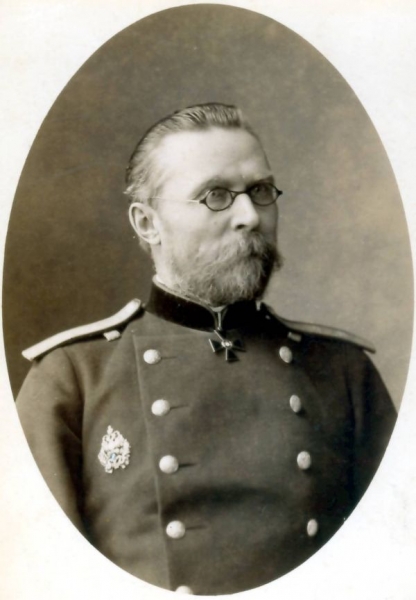 Eugene V. Pavlov
Eugene V. Pavlov
E.V. Pavlov at the Military Medical Academy held a graceful experience. Written on a soft brush cardboard sheet is applied a thin layer of carbon black, sheets themselves and located on a horizontal surface. There followed a shot from 18 steps, where the bullet had to pass directly over the cardboard. The results of the experiment showed, soot blowing (in diameter no more than 2 cm) It was possible only if the bullet was held in 1 sm above the card. If the bullet went up on 6 see above, the air is never affected the black. Generally, Pavlov proved, only shot at air mass in front of a bullet can somehow affect the flesh. And even here the more effective will be the powder gases.
Such is the triumph of the Russian military medicine.
***
Researchers wound ballistics eventually came to help perfect technique - high-speed shooting, allowing you to create a video with a frequency 50 FPS. AT 1899 by Western researcher ABOUT. tilde Using such a camera for capturing process injured brain and skull bullet. It turned, that the brain is initially increases in volume, then collapses, and the skull begins to crack after the departure of the bullet head. Tubular bones also continue to deteriorate for some time after the departure of the bullet wounds. In many ways, these new materials research ahead of their time, even though they could shed some light on the mechanism of wound healing effects. Scientists at the time carried away with a slightly different theme.
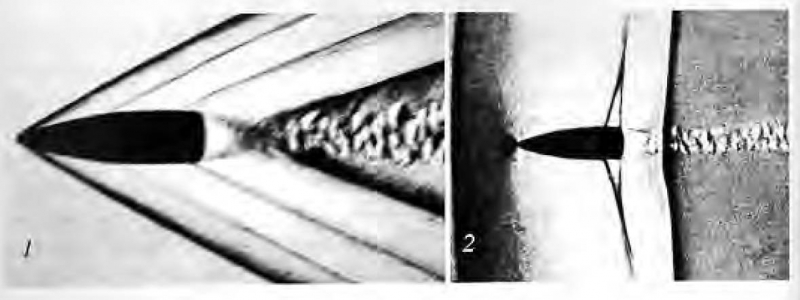 Spark pictures bullet movement in the air. 1 - the formation of a ballistic wave when the bullet moving at a speed, considerably exceeding the speed of sound, 2 - absence of ballistic wave when the bullet moving at a speed, equal to the speed of sound. A source: «wound ballistics» (A Ozeretskovsky. B., Well Gumanenko. TO., In Boyarintsev. AT.)
Spark pictures bullet movement in the air. 1 - the formation of a ballistic wave when the bullet moving at a speed, considerably exceeding the speed of sound, 2 - absence of ballistic wave when the bullet moving at a speed, equal to the speed of sound. A source: «wound ballistics» (A Ozeretskovsky. B., Well Gumanenko. TO., In Boyarintsev. AT.)
The discovery of the head of the ballistic wave, forming at supersonic flight of bullets (more 330 m / s), was another reason to explain the explosive nature of gunshot wounds. Western scholars in the early XX century thought, that the cushion of compressed air before the bullet just explains a significant expansion of the wound channel a relatively caliber ammunition. This hypothesis was refuted from two directions. At first, at 1943 year B. n. Okunev I recorded with the help of photographs of spark time span bullets over a burning candle, that does not budge.
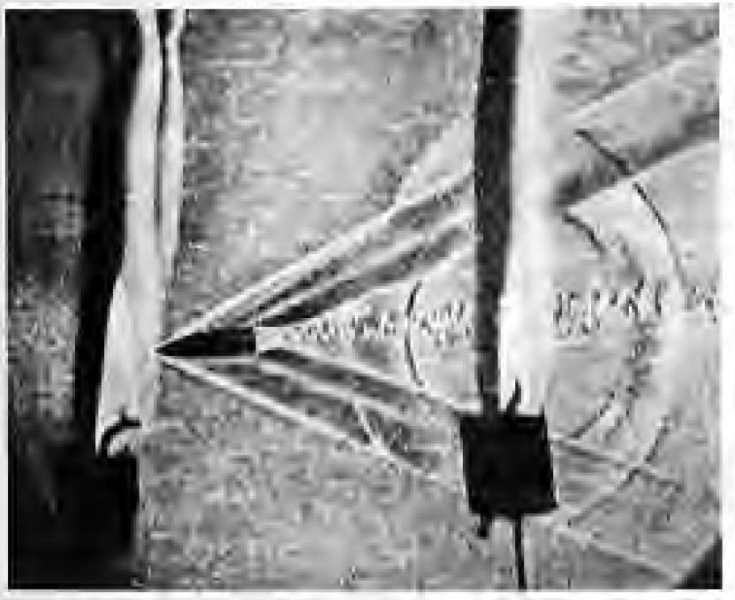 Photo spark a flying bullet with a pronounced bow wave, which does not cause fluctuations even candle flame. A source: «wound ballistics» (A Ozeretskovsky. B., Well Gumanenko. TO., In Boyarintsev. AT.)
Photo spark a flying bullet with a pronounced bow wave, which does not cause fluctuations even candle flame. A source: «wound ballistics» (A Ozeretskovsky. B., Well Gumanenko. TO., In Boyarintsev. AT.)
Secondly, Abroad we conducted a complex experiment, firing bullets from the same one and the same weapon two clay block, one of which was in a vacuum - the bow wave formed in such conditions, naturally, could not. It turned, that the apparent differences in the destruction of the blocks do not have, and therefore, and the dog was buried not in the bow wave.
And absolutely hammered the nail in the coffin of this hypothesis Russian scientist AT. n. Petrov, who pointed, bow wave that is able to be formed only in the case of, when a bullet travels faster than the speed of sound in the environment. If the air is of the order 330 m / s, in human tissues sound travels at a speed of more than 1500 m / s, that prevents the formation of a bow wave in front of a bullet. The Military Medical Academy in the 1950s, not just theoretically substantiated this position, but the example of the small intestine proved practically impossible firing head wave propagation inside the tissue.
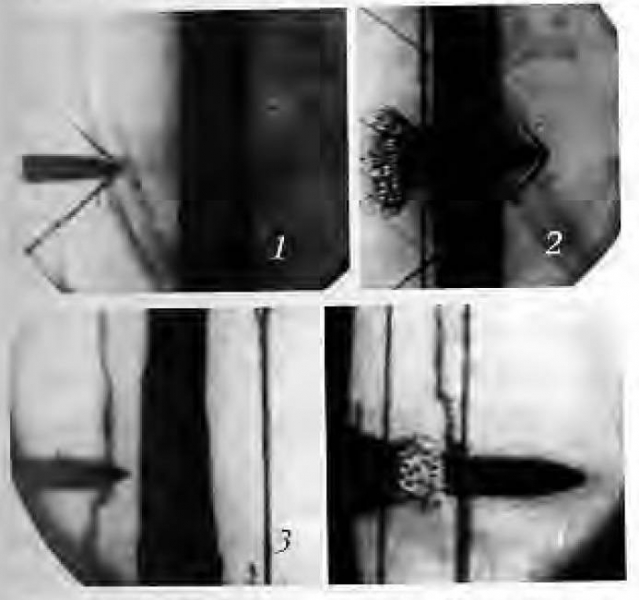 Spark pictures injured small intestine 7.62 mm bullet cartridge 7,62h54. 1,2 - speed of a bullet 508 m / s, 3,4 - speed of a bullet 320 m / s. A source: «wound ballistics» (A Ozeretskovsky. B., Well Gumanenko. TO., In Boyarintsev. AT.)
Spark pictures injured small intestine 7.62 mm bullet cartridge 7,62h54. 1,2 - speed of a bullet 508 m / s, 3,4 - speed of a bullet 320 m / s. A source: «wound ballistics» (A Ozeretskovsky. B., Well Gumanenko. TO., In Boyarintsev. AT.)
At this stage of the explanation of wound ballistics ammunition physical laws of the external ballistics proved to be passed - everyone understood, that living tissue is much more dense and less compressible, than the air environment, and therefore physical laws there are several other.
It is impossible not to talk about the snatch in wound ballistics, which happened just before the First World War. Then surgeons mass in all European countries has been concerned about the assessment of the damaging effect of bullets. Based on the experience of the Balkan campaign 1912-1913 years, Doctors noticed the German pointed bullet Spitzgeschosse or «S-bullet".
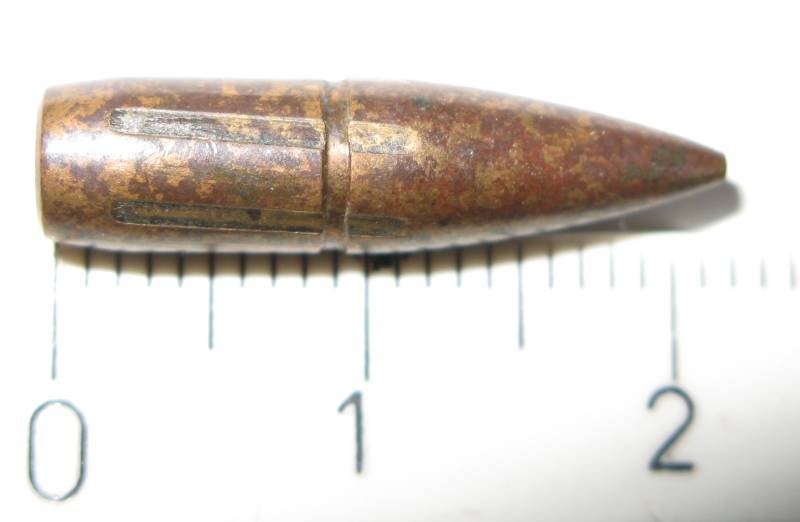 Spitzgeschosse or «S-bullet".
Spitzgeschosse or «S-bullet".
This rifle ammunition was the center of mass is displaced to the rear, which caused a rollover bullet in the tissues, and that, in its turn, dramatically increases the amount of damage. One of the researchers for the exact fixing of this effect in 1913-14 years made 26 thousand. shots of the corpses of people and animals. unknown, whether the center of gravity of «S-bullet" is specially displaced by German gunsmiths, or it was an accident, but in medical science, a new term - a side effect of a bullet. Until that time, we knew only about the direct.
The side effect is damage to tissue outside the own wound channel, which can cause severe damage, even when moving bullet wounds. Normal bullet, moving in a straight line in the tissues, spends its kinetic energy in the following proportions: 92% in the direction of its movement and 8% laterally. The increase in the share of energy consumption in the lateral direction is observed in thick-headed bullets, and also in ammunition, can tumble and deformed. As a result, after the First World War in the scientific and medical community have formed the basic concepts depending on the severity of a gunshot wound on the amount of kinetic energy transferred tissues, velocity vector and transfer this energy.
The origin of the term "wound ballistics" (wound ballistics) attributed to US researchers Callender and Frenchy, which in 30-40s closely involved with spaces gunshot wounds. Their experimental results reaffirmed the thesis of decisive importance in determining the projectile velocity gravity "ognestrela". It was also found, bullets energy loss depends on the density of damaged tissue. Most of all, the bullet "inhibited", naturally, in bone, less muscle and even less - in the light. The most severe injuries, According to Callender and French's, to expect from high-speed bullets, flying at a speed 700 m / s. It is these munitions can cause real "blast injury".
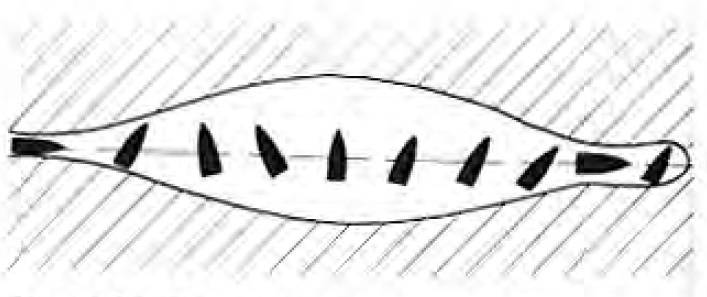 Driving movement of the bullet Callender.
Driving movement of the bullet Callender.
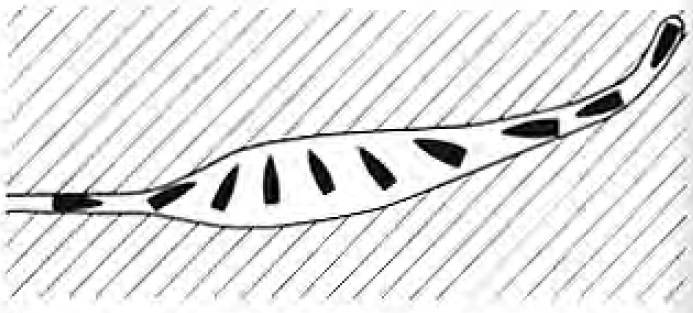 Driving bullet movement in h. B. Ozeretskovsky.
Driving bullet movement in h. B. Ozeretskovsky.
One of the first, who recorded mostly stable behavior caliber bullets 7,62 mm, become our scientists and doctors L. n. Alexandrov and L. B. Ozeretskovsky from the Military Medical Academy. FROM. M. Kirov. Firing clay blocks thickness 70 cm, scientists found, that the first 10-15 see such a bullet is moving steadily and only then begins to unfold. That is mostly bullets of 7.62 mm in the human body is quite stable and moving, under certain angles of attack, can pass right through. it, of course, sharply reduced the stopping power of the munition on enemy troops. It was after the war, had the idea of redundancy submachine gun cartridge 7.62mm and matured the idea to change the kinematics behavior of bullets in human flesh.
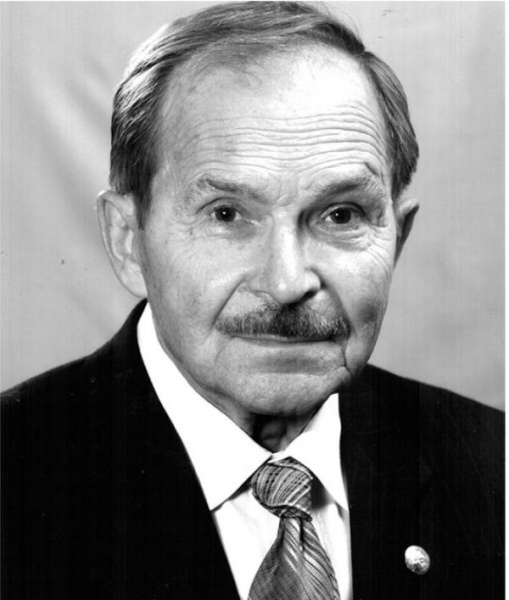
Lev Ozeretskovsky - Professor, Doctor of Medical Sciences, the founder of the Russian school of wound ballistics. AT 1958 he graduated from the Faculty of IV the Military Medical Academy. FROM. M. Kirov and was sent to serve as a doctor 43rd Infantry Regiment separate LenVO. He began his scientific career in the 1960 year, when he was transferred to the position of a junior researcher of the 19th Scientific-Research Test artillery range Physiological Laboratory. AT 1976 year for testing complex firearms 5.45 mm caliber was awarded the Order of the Red Star. A separate direction of Colonel of the Medical Service Ozeretskovsky A activity. B. at 1982 year was the study of a new type of combat disease - blunt chest and abdominal trauma, protected body armor. AT 1983 he worked in the 40th Army of the Republic of Afghanistan. He worked for many years at the Military Medical Academy in St. Petersburg.
To help in the difficult task of increasing slaughter action bullets came complicated recording equipment - Pulse (microsecond) radiography, high-speed filming (from 1000 to 40000 FPS) and a perfect spark Photo. Classical object "Vantage" for research purposes became ballistic gelatin, contouring the density and consistency of human muscle tissue. Blocks are commonly used mass 10 kg, consisting of 10% gelatin.
With these new products has been made small opening - the presence in the targeted tissues bullet temporary pulsating cavity (temporary cavity). The head of the bullet, penetrating into the flesh, significantly pushes the boundaries of the wound channel both the axis of movement, and in the hand. cavity size considerably exceeds the caliber munition, and the existence and pulsation measured in fractions of a second. After this time, the cavity "collapses", and the body is a traditional wound channel. fabrics, surrounding the wound channel, received their dose damage just during shock pulsation temporary cavity, which partly explains the explosive character of "firearms".
It is worth noting, Now that the theory of temporary pulsating cavity Some researchers have not taken as a priority - they are looking for an explanation of mechanics bullet wound. Remain poorly studied following characteristics temporary cavity: nature of ripples, relationship between the size of the cavity and the kinetic energy of the bullet, and the physical properties of the medium infestation of affected. In fact, modern wound ballistics can not fully explain the relationship between the caliber of the bullet, her energy and those physical, morphological and functional changes, that arise in the targeted tissue.
AT 1971 And, Professor. n. Golden Eagles in one of the lectures very aptly put it in relation to wound ballistics: «Continuing interest in the teachings of the gunshot wound is connected with the peculiarities of development of human society, which, Unfortunately, often uses a firearm…». nor subtract, or add. Often, this interest is confronted with scandal, one of which was the adoption of small-caliber weapons on the high-speed bullets 5,56 mm 5,45 mm. But this is the next story.
biological simulators
Natural modeling processes, occurring at gunshot wound or injury mine explosive, There are two types of simulators: biological and non-biological nature. Objects of biological origin - is first of all the dead bodies of people, parts thereof, as well as various species of mammals. To include non-biological soap and gelatin blocks, iron sheets, various types of clothing fabrics, etc..
Of course, "Shot" for research purposes cadavers and animals results in a very valuable theoretical results, but ethical considerations ... In addition, the requirements of scientific reproducibility need in the future to put an end to the firing of cadaveric. The thing is, that each human tissue have their own unique parameters - the proportion of fatty tissue, density, amount of liquid, and so on. For example, the results of ballistic tests on the corpses of women and men (biomanekeny) sometimes give very different results because of different ratio of muscle and adipose tissue.
Also makes adjustments to use the corpses of rigor mortis, changing the mechanical properties of tissues. Simply put, bombard the body is necessary immediately after death. You can not use the corpses to study physiological responses to "firearms". Therefore, in our time created considerable arsenal of non-biological simulants, the parameters of which are similar to human tissue and organs. However, simulators still left alive in wound ballistics.
In the history of wound ballistics, as well as biological objects used pigs, horses, facturer, bulls, goats, sheeps, dogs and small animals - cats and rabbits. Man very coolly walked up to the selection of potential victims science: accidents must be nonaggressive, convenient for observation, require minimal maintenance and are inexpensive. One of the bullets went first horses and cattle due to massive muscle mass, allowing to obtain a long wound channel, very convenient for study. Over time, it turned out, that working with such large animals uncomfortable, and expensive.
Since horses revealed another problem - due to poor standing dome diaphragm and severity of organs from animals in the supine position there is compression of the lower lung lobes with hypoxia. In this regard, general anesthesia is required for longer than 30 minutes with the use of expensive and complex equipment. Also adds complexity difficult digestive system of horses and bulls, that the whole experiment can suddenly ruin unconscious. Overly thick skin of these animals makes to amend the test results. Well suited for experiments on wound ballistics goats and sheep - for they are quite suitable "human" anesthesia system and medical preparations. It complicates the assessment of the damage developed a woolen blanket and a marked difference in the arrangement of the internal organs. But the dog is generally awarded the honorary title of the hero of Experimental Medicine, and wound ballistics is no exception.
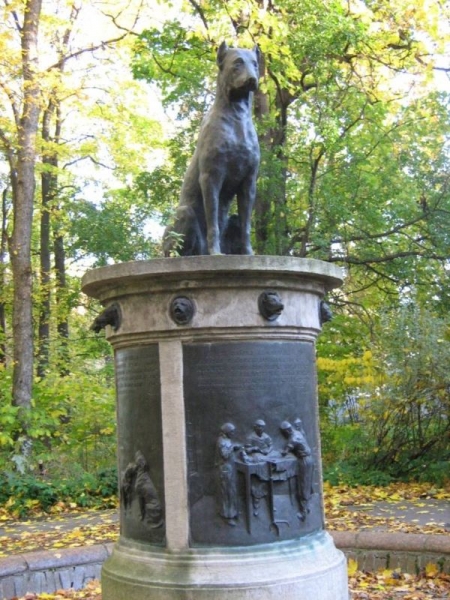 Monument Pavlov's dogs.
Monument Pavlov's dogs.
They are trained well enough and obedient, which allows for the successful work of the experimental treatment of gunshot wounds. Arteries and veins of the dogs are in good accessibility for punctures and injections. By the canine body fits perfectly general medical anesthesia techniques and standard equipment, such as an endotracheal tube and a ventilator apparatus. Generally, dog best friend, a specialist in wound ballistics? not really. Very thin skin, weakly related to the underlying tissues, in contact with the bullet breaks into pieces large area to form deep pockets. This is not a characteristic of the human skin, so the accuracy of experiments suffers. Also, if you want to study a large muscle mass, We have to look for large dogs, weighing more than 40 kilograms, it is also problematic.
To help the dog in such a delicate matter came pig, remarkably similar to the human body, not only on the structure of, but even in biochemistry. It is actively used for transplantation and other medical experimenters. But these animals, Unlike dogs, reluctant to give herself for blood sampling or administration of anesthesia, generally, behave in this sense as a true pig. There are difficulties with mechanical ventilation - a tendency to spasm of the larynx can block intubation. Very good on pigs to examine the outer picture of gunshot wounds to the detailed assessment of the input and output openings.
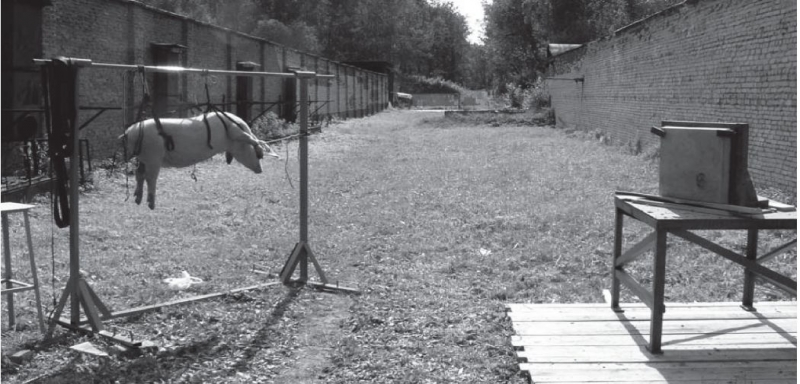 Location obstacles and animals before the experiment for studying the lethal action ricochet bullets. A source: Herald of the Russian Academy of Military Medicine
Location obstacles and animals before the experiment for studying the lethal action ricochet bullets. A source: Herald of the Russian Academy of Military Medicine
How to carry out tests on animals firearms? the animals up to the experiment in the vivarium watch for 5-7 day, and just before the "hour X» accidents immersed in anesthesia and fixed. The criterion of the level of anesthesia is reduced reflexes and skeletal muscle tone. Shoot at animals with bullets The figure and the actual distances. Weapons have to 8-10 meters from the animal (Bullet time to stabilize), but the powder fill up as much, as you need to break up bullets to the required speed. Less powder - less than the speed of a bullet, respectively, investigated range will be longer. Difficulties with the range really is, what exactly is there from a distance, for example, at 500 meters in the living target is very difficult. A direct hit is a specified point on the body of the victim is a prerequisite for high-speed video and X-ray pulse.
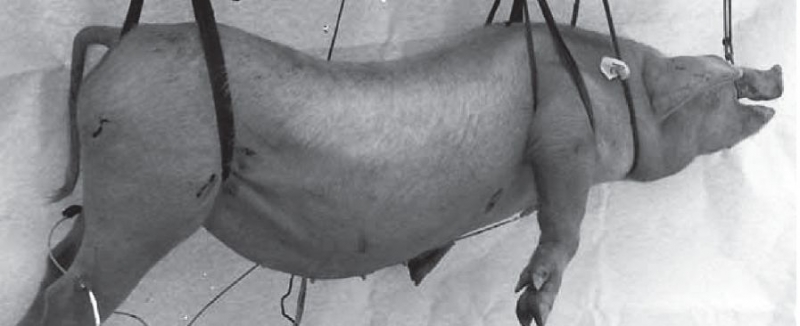 Pig under anesthesia and connected to recording equipment. A source: Herald of the Russian Academy of Military Medicine
Pig under anesthesia and connected to recording equipment. A source: Herald of the Russian Academy of Military Medicine
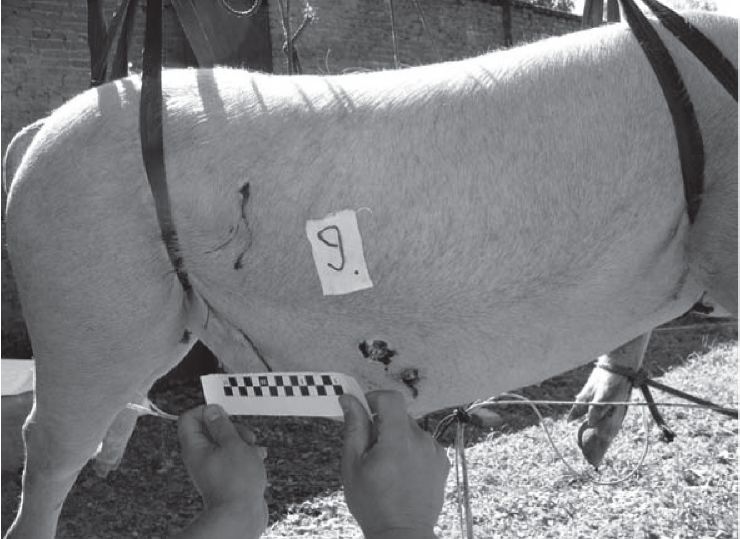 Appearance input bullet holes at wound bullet fragments SP10 cartridge. A source: Herald of the Russian Academy of Military Medicine
Appearance input bullet holes at wound bullet fragments SP10 cartridge. A source: Herald of the Russian Academy of Military Medicine
At the same time it gives the actual distance of the most tangible results - the bullet retains the natural driving conditions. In the case of fatal injury is held full inspection cycle, followed by opening the corpse. In non-fatal wounds studied behavioral activity and the entire spectrum of physiological functions - from nervous system state to peripheral vascular tonus.
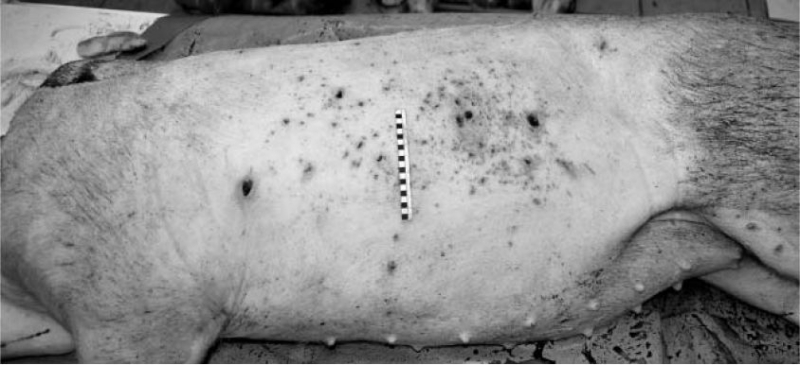 The picture wound experimental animal after overcoming obstacles solid bullet. A source: Military Medical Journal.
The picture wound experimental animal after overcoming obstacles solid bullet. A source: Military Medical Journal.
On the question of ethics. AT 1959 by British researchers Russell and Burch proposed the concept of the "three R» («The three Rs»), which should be followed when carrying out any traumatic experiences with animals. three components: replacement - replacement, reduction - reduction and refinement - improving the quality of.
the substitution principle It requires, possibly, replace animal models and other techniques (mathematical, for example), but instead use a mammalian animal with a less developed nervous system.
The principle of reduction It involves the use of a "brutal" experiments the smallest possible number of animals.
The third principle, quality improvement, It requires the use of the best possible high-tech equipment and drugs for anesthesia. Must animals from the experiment is also necessary as far as possible painless.
Much to comply with these recommendations rests with the Ethics Committees. For example, at the Military Medical Academy. FROM. M. Kirov has an independent board of ethics, which the, among other things, following the order of use of laboratory animals in biomedical experiments.
At present, neither in Russia, nor the world's experts on wound ballistics of firearms can not eliminate the use of animals and cadaveric material, even taking into account a wide variety of simulators of non-biological origin.








